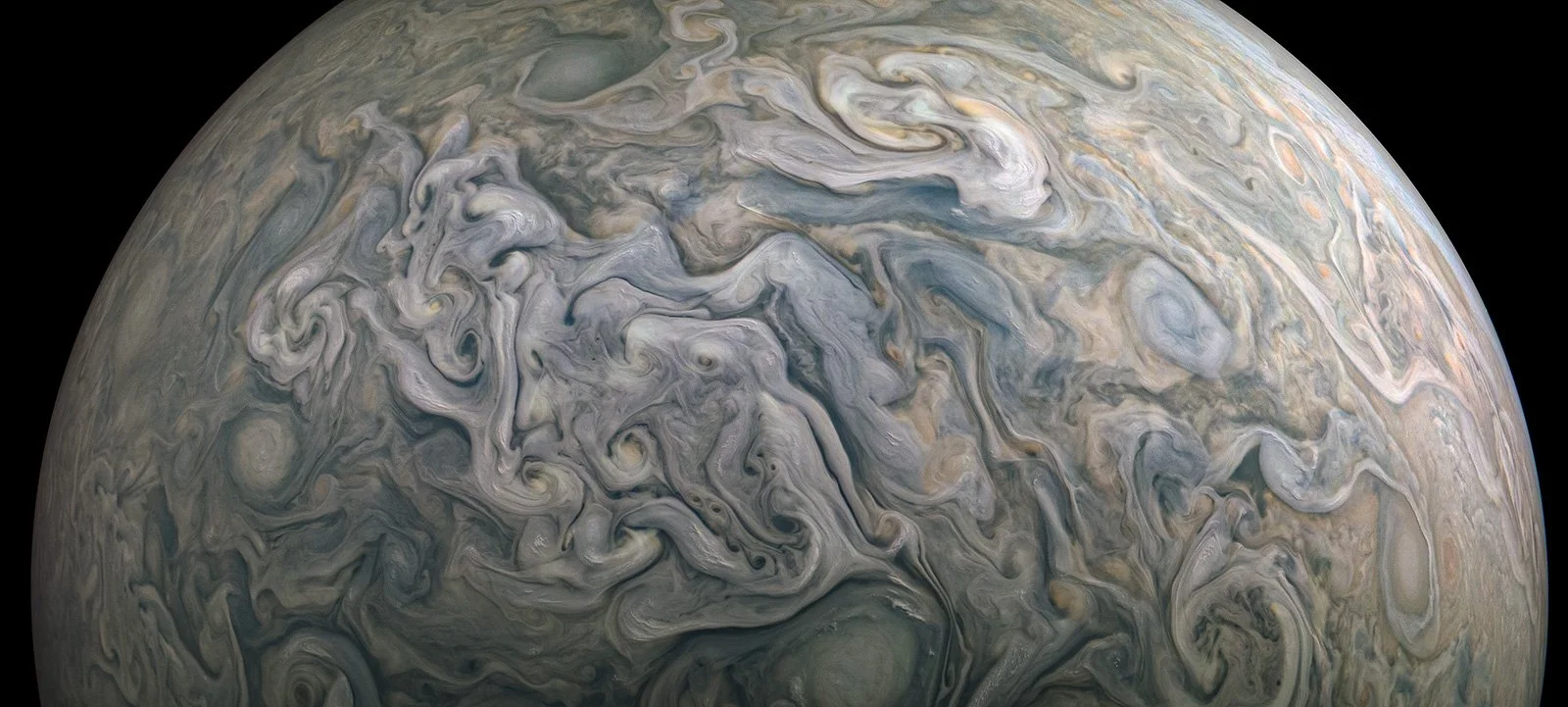
Turbulence
Atmospheric gases that are sliding past each other tend to swirl, producing a cascade of smaller eddies
Shear Flow
Adjacent layers of atmospheric gas often move at different speeds. At the interface is a shear flow described by the quantity $$\frac {\partial v_x} {\partial y}$$which expresses how strongly the flow speed $v_x$ in the $x$ direction parallel to the interface depends on location in the $y$ direction perpendicular to the interface. This type of interface tends to be unstable in an atmosphere, because the shear flow develops eddies that spawn smaller and smaller eddies, making the flow in that region chaotic and turbulent.
Momentum Transfer
The shear-flow interface between two gas layers cannot be infinitely sharp (with $\partial v_x / \partial y \rightarrow \infty$). Molecular interactions between gas particles at the interface inevitably transfer momentum from one layer to the other, producing the phenomenon called viscosity. However, the interface itself can be unstable even if viscosity is negligible.
Consider what happens near the interface if something introduces a slight rippling of wavelength $\lambda$, so that $$\delta y \propto \sin 2 \pi x /\lambda$$describes the displacement of the interface in the $y$ direction. In that case, the flow of one layer past the other undergoes slight changes of direction in the vicinity of the interface. If the relative flow speed is $v_x$, then $$\delta v_y = v_x \tan 2 \pi x /\lambda$$is the flow speed in the $y$ direction at the interface.
The flowing gas is therefore experiencing periodic accelerations, implying the presence of pressure imbalances in the $y$ direction that would not otherwise be present without the ripple. Gas moving into a trough of the ripple is gradually being accelerated away from the interface, meaning that it is transferring momentum to gas on the other side of the interface and pushing it in the opposite direction. Similarly, gas moving past a bulge in the ripple is gradually being accelerated toward the interface, meaning that it is transferring momentum away from the interface, pushing the flowing gas layer away from the bulge in the interface.
Such a ripple is unstable, because both of those acceleration effects cause the ripple to grow more pronounced: Each trough becomes deeper and each bulge grows larger. This type of atmospheric instability is known as a Kelvin-Helmholtz instability. It is how wind amplifies small ripples into large water waves, and it is responsible for many other atmospheric phenomena.
Eddies
As the ripple amplified by such an instability grows larger, gas flowing past a bulge in the interface starts to form eddies downstream of the bulge. The effect is similar to the flow of water past a rock in a stream. Downstream of the rock and immediately behind it, a low-pressure region develops. Instead of flowing past the rock, some of the water circles back into the low-pressure region. That circulation pattern is what forms an eddy.
However, the creation of an eddy makes the shear flow more complex, with multiple smaller shear-flow interfaces within it. Each one of those interfaces is itself unstable and produces more eddies. A cascade of eddies on increasingly small scales results from the original shear flow. The image at the top of the page (from the Juno mission) shows a variety of eddies that have resulted from shear flows in Jupiter’s atmosphere.
Turbulent Cascade
The cascade of eddies resulting from a low-viscosity shear flow ultimately becomes so chaotic that we call it turbulence. Its details are not precisely predictable, but the cascade does have predictable statistical propreties.
A statistical description of turbulence starts with specifying the size scale $\lambda_{\rm max}$ and circulation speed $v_{\rm max}$ of the largest eddies. They complete one circulation cycle on a timescale $t_{\rm eddy} = 2 \pi \lambda_{\rm max} / v_{\rm max}$. During that time they transfer much of their original kinetic energy to the smaller eddies they generate. Those smaller eddies then transfer their kinetic energy to even smaller eddies.
That process of energy transfer continues until the kinetic energy reaches eddies so small that viscosity inhibits their circulation. On that size scale, molecular interactions convert the kinetic energy of circulatory motion into the randomized form of kinetic energy called heat. Without continual energy input into the largest eddies, turbulence therefore gradually subsides, as you can see for yourself by observing a coffee cup after you stop stirring it.
Continuous energy input, on the other hand, leads to a steady state in which energy continually cascades down to the smallest eddies and dissipates into heat. In this steady state, the kinetic energy per unit mass in the largest eddies is approximately $v_{\rm max}^2/2$. The rate at which turbulence converts kinetic energy into heat is therefore approximately $$\frac {v_{\rm max}^2} {2 t_{\rm eddy}} = \frac {v_{\rm max}^3} {4 \pi \lambda_{\rm max}}$$At every stage of the continuous cascade, from the largest eddies down to the smallest ones, the transfer rate of kinetic energy must be the same in order for the statistical properties of the whole cascade to remain steady.
Velocity Structure
The approximate energy transfer rate $$\frac {v_{\lambda}^2} {2} \left( \frac {2 \pi \lambda} {v_{\lambda}} \right)^{-1} = \frac {v_{\lambda}^3} {4 \pi \lambda}$$through eddies of size $\lambda$ and circulation speed $v_{\lambda}$ cannot depend on $\lambda$ in a steady cascade. Otherwise, the circulation speed $v_{\lambda}$ would increase with time for the values of $\lambda$ at which energy transfer is particularly slow. The relation $$v_{\lambda} \propto \lambda^{1/3}$$must therefore hold for eddies of all sizes in a steady turbulent cascade.
If that proportionality relation applies everywhere in the cascade, then the average velocity difference between any two locations separated by a distance $r$ is proportional to $r^{1/3}$. The typical differences in relative flow speed are largest for $r$ similar to the sizes of the largest eddies, and they decrease as $r$ decreases. (This relationship is sometimes called the Kolmogorov spectrum of turbulence.)